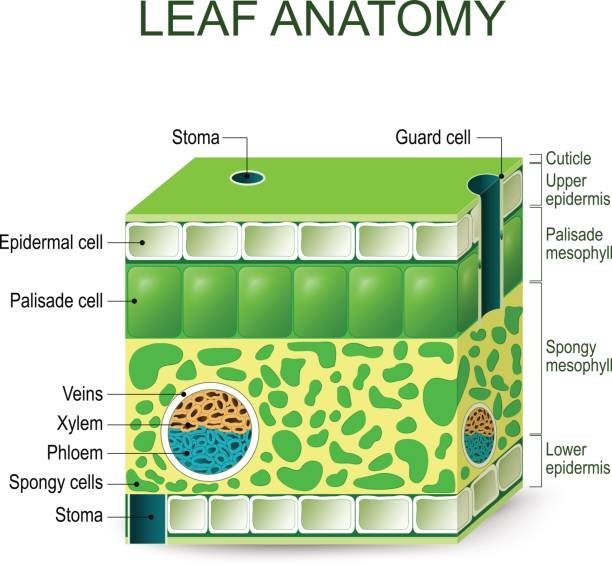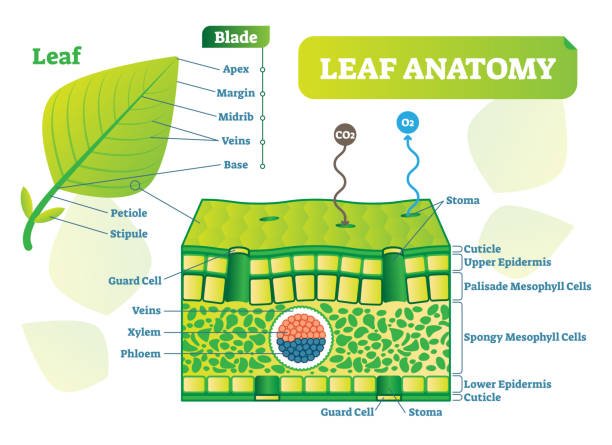On this page, we explain how the spongy mesophyll cells are adapted for their functions.
The spongy mesophyll cells are a critical component of plant leaves and play an essential role in photosynthesis and other functions. Their structure and characteristics are specifically adapted to facilitate these functions.
How the Spongy Mesophyll Cells are Adapted for Their Functions
The spongy mesophyll cells are adapted for their functions because of the following:
- Location: Positioned in the middle layer of the leaf for assisting in gas exchange and water movement.
- Loose and Irregular Shape: Allows large air spaces for free movement of gases like CO2 and O2.
- Adaptation for Gas Exchange: Facilitates efficient diffusion of gases essential for photosynthesis.
- Connection to Stomata: Ensures quick movement of gases in and out of the leaf.
- Moist Surface: Enhances gas diffusion by improving solubility.
- Flexible Cell Walls: Allows for expansion and contraction, aiding in water and nutrient movement.
- Chloroplast Presence: Enables participation in photosynthesis for additional energy production.

Here’s a detailed look at these adaptations:
1. Location within the Leaf:
The spongy mesophyll cells are found in the middle layer of the leaf, just below the palisade mesophyll cells, which are tightly packed and primarily involved in photosynthesis. The spongy mesophyll’s location allows them to assist in various functions, including gas exchange and water movement.
2. Loose and Irregular Shape:
Unlike the palisade mesophyll cells, the spongy mesophyll cells have a more irregular and loose arrangement. This creates large air spaces between the cells that allow gases like carbon dioxide (CO2) and oxygen (O2) to move freely within the leaf.
3. Adapted for Gas Exchange:
The large air spaces in the spongy mesophyll layer facilitate efficient gas exchange, a vital part of the photosynthesis process. CO2 is taken in from the air, and O2, a by-product of photosynthesis, is released. These spaces act as channels, allowing the gases to diffuse efficiently between the inside and outside of the leaf.
4. Connection to Stomata:
The spongy mesophyll cells are closely connected to the leaf’s stomata, small openings on the leaf’s surface that control gas exchange. This relationship ensures that the gases can move in and out of the leaf quickly, responding to the plant’s needs.
5. Moist Surface for Better Gas Diffusion:
The spongy mesophyll cells often have a moist surface, which improves the solubility of gases, thereby facilitating more efficient gas diffusion. This moisture is maintained by the plant’s transpiration process, where water is lost through the stomata.
6. Flexible Cell Walls:
The flexibility in the cell walls of the spongy mesophyll allows for expansion and contraction. This adaptability helps in accommodating changes in water pressure and aids in the movement of water and nutrients within the plant.
7. Chloroplast Presence:
Though not as packed with chloroplasts as the palisade mesophyll, the spongy mesophyll cells do contain chloroplasts, allowing them to participate in photosynthesis. This additional capacity ensures that the plant can maximize its energy production.
Conclusion:
The spongy mesophyll cells’ unique adaptations make them indispensable in plants’ photosynthesis process and overall function. From their irregular shape and strategic location to their connection with the stomata and chloroplast content, every aspect of these cells is fine-tuned to support the plant’s life processes. These adaptations are found in various plant species across different climatic regions, from the tropical rainforests of Brazil to the arid deserts of Africa, reflecting the universal importance of these cellular structures in plant biology.

